Vaslui
Vaslui (Romanian pronunciation: [vasˈluj]), a city in eastern Romania, is the seat of Vaslui County, in the historical region of Western Moldavia.
Vaslui | |
|---|---|
Vaslui cityscape | |
 Coat of arms | |
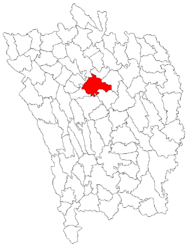 Location in Vaslui County | |
 Vaslui Location in Romania | |
| Coordinates: 46°38′18″N 27°43′45″E | |
| Country | |
| County | Vaslui |
| Government | |
| • Mayor | Vasile Pavăl[1] (PSD) |
| Population (2011)[2] | 55,407 |
| Time zone | EET/EEST (UTC+2/+3) |
| Vehicle reg. | VS |
| Website | www |
The city administers five villages: Bahnari, Brodoc, Moara Grecilor, Rediu and Viișoara.
History
Archaeological surveys indicate that the territory of Vaslui was inhabited since the Neolithic. From the 14th century onwards, it developed as the provincial town of Vaslui, with a population that fluctuated considerably in the following centuries. The name of Vaslui appears first in a Polish document from 1375, referring to Koriat's son Yuri Koriatovich. The name Vaslui was also mentioned in 1435, in connection with the accession of Prince Iliaș to the Moldavian throne. The town was burned to the ground in 1439 and 1440 when Tatars invaded Moldavia.
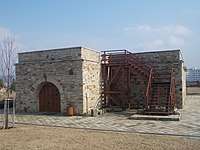
The peak of Vaslui's importance was in the 15th century, when it was a second-rank capital of Moldavia, during the reign of Stephen the Great (r. 1457-1504) and its population approached that of the neighbouring Iași. In 1475, Prince Stephen won his greatest battle against the Ottoman Empire in the Vaslui area. Once the Moldavian capital was moved from Suceava to Iași and the southern town of Bârlad became an administrative center of southern Moldavia, Vaslui declined for the next three centuries to eventually become a local borough (târg).
There once was a fairly large Jewish community in the city of Vaslui. Its arrival from Galicia during the second half of the 19th century gave a new impetus to local economic development. In 1899, Jews formed 37% of the population, and Vaslui was home to the Vasloi Hasidic dynasty. However, waves of pogroms, associated with the Holocaust (see Romania during World War II and Holocaust in Romania) as well as emigration to Israel during Romania's communist period decimated this population.
During World War II, the Stephen the Great Monument was relocated from Chișinău to Vaslui. On 22 August 1944, Vaslui was captured by Soviet troops of the 2nd Ukrainian Front in the course of the Jassy–Kishinev Offensive.
The population of Vaslui grew steadily again after 1968, when the town was proclaimed as the administrative center of Vaslui County, with immigration from the neighbouring countryside, attracted by the industries set up by the Communist regime.
Demographics
According to the last census, from 2011, there were 55,407 people living within the city of Vaslui,[3] making it the 40th largest city in Romania. The ethnic makeup is as follows:
- Romanians: 98.63%
- Romani people: 1.19%
- Lipovans: 0.06%
- Other: 0.12%
The population decreased again after the downfall of Communism in 1989, due to low fertility rate, and emigration.
The majority of the population is of Romanian ethnicity. The Roma minority lives compactly in the southwestern suburbs of Rediu and Brodoc, in the southwestern part of the main town (in the neighbourhoods around Traian Street) and also scattered in the rest of the locality. In the 1960s and '70s nomadic Roma belonging to the Kalderash caste were forcibly settled by the Communists in the northern part of the town, scattered among ethnic Romanians. The third ethnic group is that of the Lipovans, who have in the center of the town a church of their Old Believers Christian branch.
Censuses
| Year | Population |
|---|---|
| 1912 | 10,397 |
| 1930 | 15,310 |
| 1941 | 13,923 |
| 1948 | 13,738 |
| 1956 | 14,850 |
| 1966 | 17,591 |
| 1977 | 39,435 |
| 1992 | 80,614 |
| 2002 | 70,571 |
| 2011 | 55,407 |
According to data provided by Romanian officials in 2017, the population of Vaslui is 100,170. The substantial increase compared to the latest census figure is due to the fact that tens of thousands of dual citizens from neighboring Moldova come to Vaslui for their identity documents, where a Vaslui address is listed.[4]
Districts
Vaslui has several neighborhoods: 13 Decembrie, Ana Ipătescu, Castanilor, Copou, Delea, Alecu Donici, Gheorghe Racoviță, Green Park, Gura Bustei and Traian.
Education
The city has ten schools, classes I - VIII, named after Ioan Cuza, Dimitrie Cantemir, Constantin Parfene, Elena Cuza, Ștefan cel Mare, Mihai Eminescu, Constantin Motaș, Alexandra Nechita, Vasile Alecsandri, Mihail Sadoveanu.
The city also has six high schools, named after Mihail Kogălniceanu, Emil Racoviță, Anghel Rugină, Ștefan Procopiu and Ion Mincu, as well as a Sports High School.
Economy
The main industries are textiles (clothing and knitted wear) and food (baked goods, vegetable oil, meat, dairy). There are also a number of shopping centers and supermarkets.
Transport

The newly modernized train station is located in the south of the city.
In July 1994, a trolleybus line opened. It closed in July 2009, reopening in August 2016.[5]
In the city, public transport is provided by buses and taxis.
The DN24 road passes through the city in a north-south direction (Iași-Bârlad). The DN2f heads west to Bacău, and the DN15D north-west to Piatra Neamț. European route E581 lies to the south-east.
Sport
Vaslui is home to FC Vaslui football club which played in Liga I until 2014, and HC Vaslui handball club which are playing in Liga Națională.
.jpg)

Natives
Twin towns
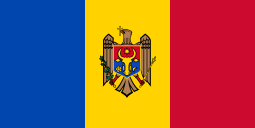

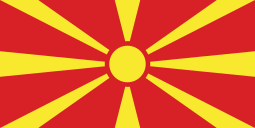

Gallery
 Civic Square
Civic Square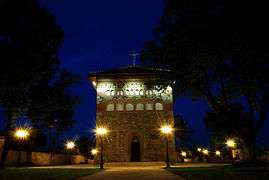 Princely Church
Princely Church Copou Park
Copou Park- Civic Square
 House of Culture
House of Culture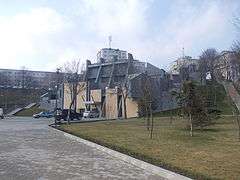 The Summer Theatre
The Summer Theatre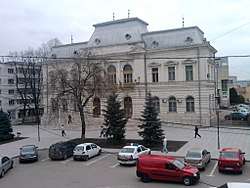 Palace of Justice
Palace of Justice City Hall
City Hall- County Hospital
- Central Mall (red)
- Mavrocordat Palace
 Old Railway Station
Old Railway Station "Mihail Kogălniceanu" High School
"Mihail Kogălniceanu" High School Courthouse (1907)
Courthouse (1907)
References
- "Results of the 2016 local elections". Central Electoral Bureau. Retrieved 3 April 2020.
- "Populaţia stabilă pe judeţe, municipii, oraşe şi localităti componenete la RPL_2011" (in Romanian). National Institute of Statistics. Retrieved 4 February 2014.
- "Population at 20 October 2011" (in Romanian). INSSE. January 2014. Retrieved 18 June 2016.
- (in Romanian) "Vasluiul s-a umflat: oficial, resedința județului a trecut de 100.000 de locuitori", Vremea nouǎ, May 1, 2017
- "EU funds Romanian trolley revival" Buses issue 738 September 2015 page 25
External links
| Wikimedia Commons has media related to Vaslui. |
| Wikisource has the text of the 1911 Encyclopædia Britannica article Vaslui. |
